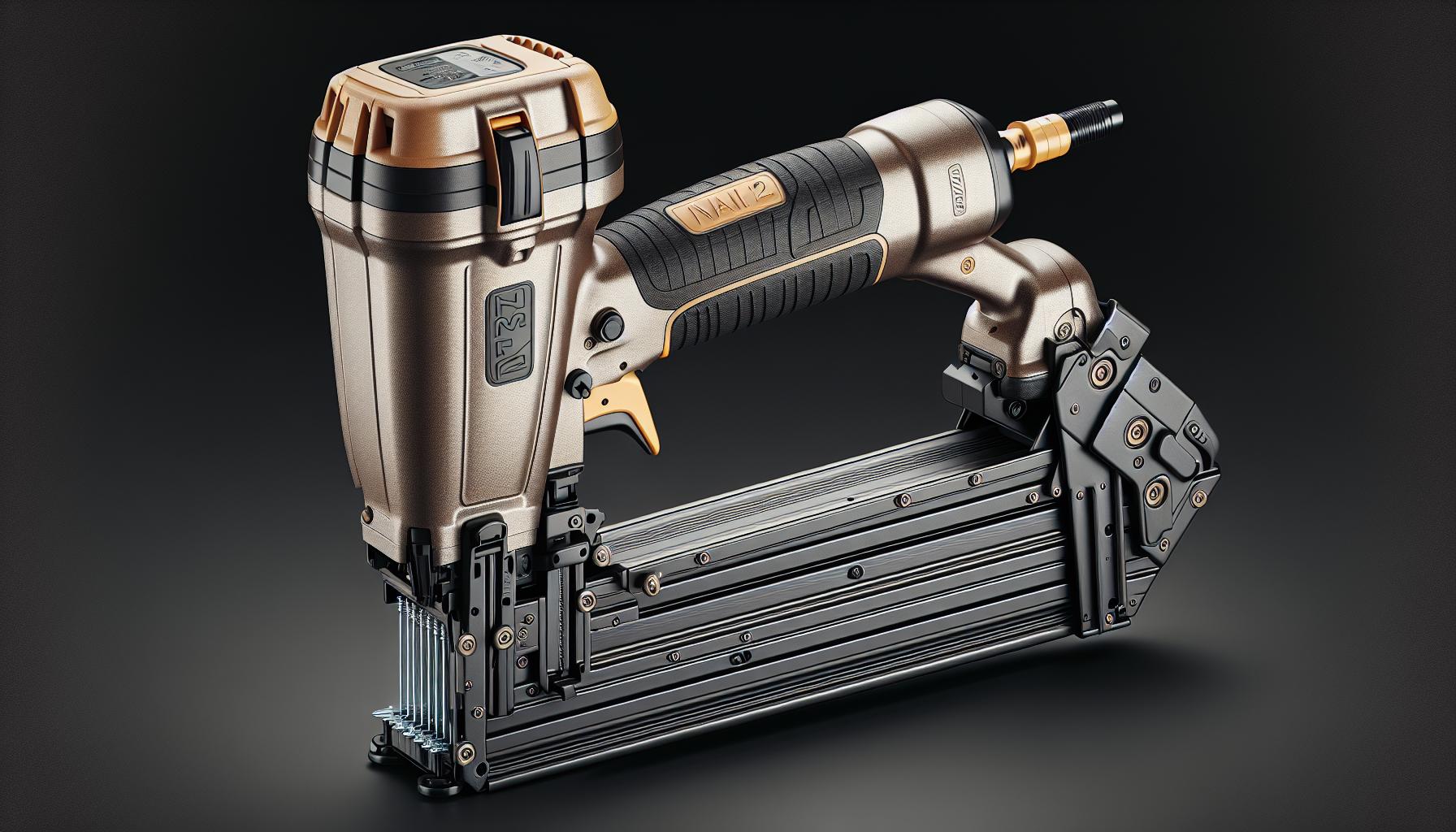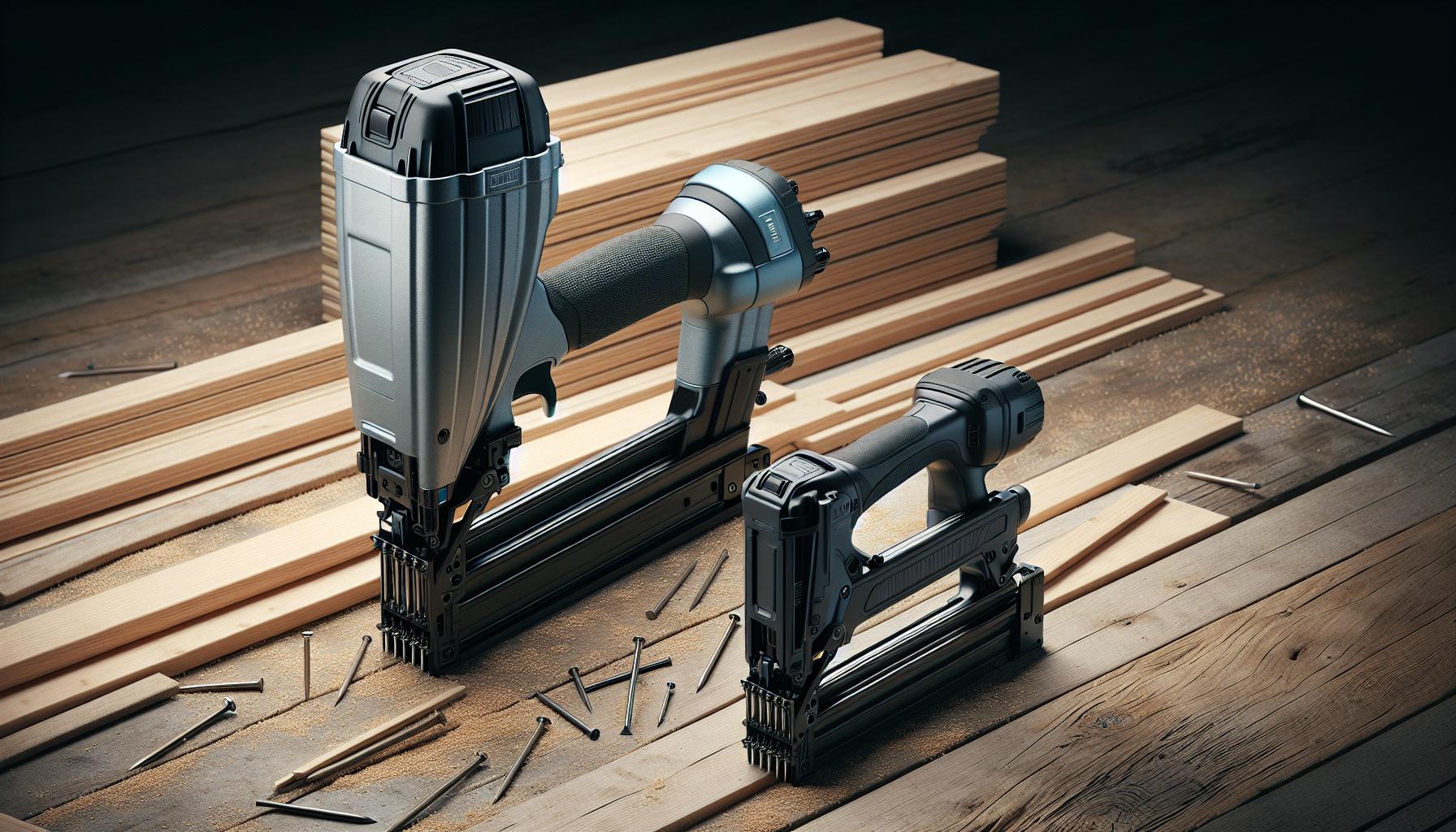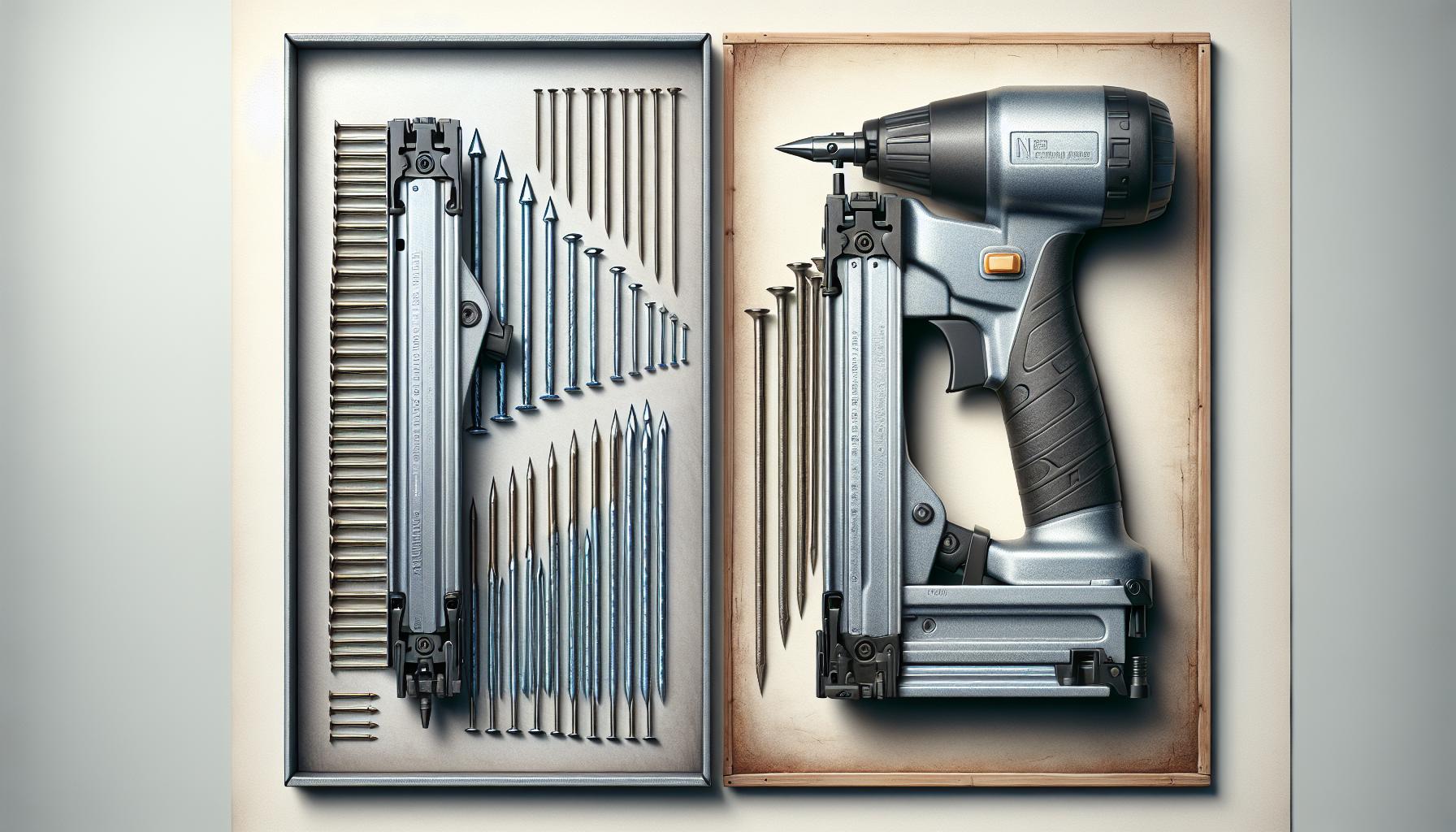When tackling a woodworking project, choosing the right tool is crucial to achieving that professional finish. That’s where understanding the difference between a finish nailer and a framing nailer comes into play. These powerhouses may look similar, but they serve very different purposes in the world of construction and DIY.
Finish nailers are the go-to for precision work, perfect for those delicate trim jobs that demand a clean look. On the other hand, framing nailers are the heavy hitters, designed to piece together the structural elements of a build with their larger nails. I’ll help unravel the specifics so you can nail your project with confidence.
What is a Finish Nailer?
When I’m working on a project that requires a blend of muscle and finesse, I reach for my finish nailer. It’s a specialized tool in my arsenal, perfect for attaching delicate trims and molds without causing damage. Unlike its robust cousin, the framing nailer, the finish nailer is adept at precision work, where a less conspicuous nail head is desirable.
Finish nailers are engineered to handle 15 or 16-gauge nails, which are thinner and shorter compared to framing nails. These nails range typically from about 1 to 2.5 inches in length. They leave behind a smaller hole, making them ideal for jobs where the finished appearance is crucial. Here’s a quick rundown of the finish nailer’s properties:
- Optimal for detailed trim work
- Utilizes thinner gauge nails for a cleaner finish
- Less powerful than framing nailers but more precise
The beauty of a finish nailer lies in its ability to affix trim and molding without splitting the wood. It’s a go-to choice for:
- Installing crown molding
- Adding chair rails
- Securing baseboards
- Attaching delicate millwork
I’ve found that one of the major benefits of using a finish nailer is the reduced time spent on prep and finishing. The smaller nail holes can be easily filled and painted over, blending seamlessly into the woodwork. For projects demanding a polished look – think custom cabinetry or staircases – having a finish nailer in your toolkit is non-negotiable.
With a finish nailer, you have to be careful not to apply too much force as you work to prevent damage. It’s less about applying sheer power and more about precise placement and subtle execution. This tool is powered by either compressed air, electricity, or batteries, offering convenience and portability. Plus, many models now come equipped with adjustable depth settings, allowing for even greater control over your work.
Bear in mind, however, that finish nailers are not suitable for heavy-duty construction where larger, more robust nails are needed. For that, you’d require the sturdier framing nailer.
What is a Framing Nailer?
Delving into the robust counterpart of finish nailers, I find framing nailers stand out for their brawn and size. These power tools are engineered for more demanding jobs where structural integrity is top priority. I’ll guide you through the essential characteristics of framing nailers, setting them apart for their heavyweight tasks.
Framing nailers, also known as framing guns or nail guns, are designed to punch through the dense material with ease. Unlike finish nailers, which handle the finer details, framing nailers are all about construction that requires significant holding power. These nailers use larger nails, typically ranging from 2 inches to 3.5 inches in length. These are the tools I reach for when I’m working on:
- Building decks
- Constructing room additions
- Remodeling homes
- Fencing projects
The nails used by framing nailers are generally referred to as framing nails, and they’re much thicker in diameter compared to those used in finish nailers. This difference in nail size means framing nailers leave a more conspicuous hole, definitely not something I would recommend for intricate trim work but absolutely a necessity for framing jobs where the nails will be hidden from view.
Framing nailers also exhibit a choice of power sources similar to finish nailers. Pneumatic framing nailers run on compressed air and are a favorite of mine for their consistent driving power and reliability. Battery-operated models offer portability and the convenience of not being tethered to an air compressor.
Finally, considering the bulk and strength of framing nailers, they’re furnished with features that support user comfort despite their heavy-duty nature. Ergonomic grips, adjustable depth settings, and even anti-jamming mechanisms make them a lot more user-friendly, even for extended periods. When I’m handling larger projects that require nailing together hefty materials, it’s a framing nailer that I depend on for getting the job done efficiently.
Differences in Size and Weight
When I’m juggling between finish nailers and framing nailers, one of the most noticeable contrasts is their size and weight. Finish nailers are generally lighter and more compact. This sleek design is intentional, allowing for precision in attaching delicate trim and molding without splitting the wood. In contrast, framing nailers are bulkier and heavier; they’re built to handle the rigors of framing work, where the size and weight of the nailer reflect the robustness required for driving larger nails into tougher materials.
Here’s a quick rundown of the typical size and weight differences:
| Nailer Type | Average Weight | Length Range |
|---|---|---|
| Finish Nailer | 3.5 – 5 lbs | 10 – 12 inches |
| Framing Nailer | 7 – 9 lbs | 18 – 20 inches |
These differences may not seem like much on paper, but they’re quite significant during extended use. The lightweight nature of a finish nailer reduces arm fatigue, allowing for comfort and ease when I’m working on intricate finish work for long periods. When I switch over to a framing nailer, I can feel the additional heft. This extra weight, though, equates to the power needed to drive nails through denser, structural lumber.
The size and weight of the nailers also dictate their maneuverability. With a sleeker finish nailer, I can easily navigate tight corners and reach confined spaces that a framing nailer can’t match. Imagine trying to use the heavier, larger framing nailer for detail work; it simply doesn’t have the delicate touch needed. Conversely, a finish nailer wouldn’t stand a chance in the demanding environment of framing, where I require a tool that’s designed for large-scale, heavy-duty tasks.
Nail Types
In my experience, understanding the types of nails each nailer uses is crucial for a successful project. Finish nailers and framing nailers are both designed for specific nail sizes and functions. Finish nailers typically utilize lighter gauge nails, often referred to as ‘finish nails’. These nails range in size from 1 to 2.5 inches in length, and their diameters are usually smaller to ensure a discreet appearance once in place. Perfect for delicate trim work, the slender design of finish nails also minimizes wood splitting, preserving the aesthetics of your project.
With framing nailers, we’re dealing with much larger nails known as ‘framing nails’. These can vary in size considerably, from approximately 2 to 3.5 inches in length. Due to the sturdy nature of the tasks at hand, these nails are crafted with a greater diameter providing the strength required for framing, sheathing, and subflooring. The larger heads of framing nails also contribute to their holding power, ensuring structures are securely fastened together.
It’s worth noting that both finish nails and framing nails come in a variety of types, including:
- Galvanized nails, which offer resistance to rust
- Stainless steel nails for maximum durability
- Coated nails, where a glue-like substance is applied to increase grip strength
The type of nail you choose will also be determined by the material you’re working with and the environmental conditions it’ll be subjected to. The compatibility of nail type with your nailer is essential; using inappropriate nails can not only compromise your work but also damage the tool itself.
Selecting the right nail and nailer combination is a balancing act—a blend of size, strength, and subtlety. Weighing these aspects carefully will lead to both a secure structure and a polished finish. Always double-check your nailer’s specifications to ensure you’re equipped with the correct nails for your particular job. It’s the kind of attention to detail that pays off in the longevity and finish of your handiwork.
Applications and Uses
When it comes to the practical applications of both finish and framing nailers, I’ve observed that each tool excels in different scenarios. Finish nailers are my go-to for precision tasks where appearance is paramount. Here’s where I find they shine:
- Trim Work: Installing detailed trim around windows and doors is effortless with a finish nailer.
- Cabinetry: Attaching delicate molding on cabinetry requires the finesse that a finish nailer offers.
- Furniture Construction: Assembling furniture pieces often needs the less intrusive finish nails to maintain integrity and aesthetics.
In contrast, the robust construction of framing nailers makes them ideal for structural projects where strength and holding power outweigh subtlety. They’re indispensable in these areas:
- Building Framework: Whether I’m constructing walls or homes, framing nailers help me secure the structure swiftly and reliably.
- Decking and Fencing: Outdoor constructions like decks and fences demand the sturdiness that framing nails provide.
- Sheathing: Applying wooden boards or heavy-duty material to walls, roofs, and floors requires the forceful drive of a framing nailer.
Moreover, it’s important to match the tool to the project to ensure not only effectiveness but also safety. Using finish nails for framing can lead to structural failures, while using framing nails for trim can damage the material and mar the finish. I always ensure I’m using the right nailer and nail type for the job.
Remember, the best results come from using the tools as they’re intended. I’ve learned this through years of hands-on experience and countless projects. Whether adding elegant finishing touches with a finish nailer or piecing together the bones of a new addition with a framing nailer, understanding their applications leads to professional-quality outcomes every time.
Conclusion
Choosing the right nailer for your project is crucial. I’ve highlighted the distinct differences between finish and framing nailers, emphasizing the importance of considering their size, weight, and the type of nails they use. Remember, a finish nailer’s light frame is perfect for detailed work where precision is key, while a framing nailer’s robust build is designed for tougher jobs that require more power. Always ensure you’re using the right nails and nailer for the task at hand to guarantee the best results and maintain safety. Whether you’re adding the finishing touches to a piece of furniture or erecting the bones of a new home, knowing these tools’ capabilities will help you work smarter and more efficiently.
Frequently Asked Questions
What is the main difference between finish nailers and framing nailers?
Finish nailers are lighter and designed for precision tasks, while framing nailers are heavier and suited for structural projects requiring more power.
Can a finish nailer be used for heavy-duty tasks like framing?
No, a finish nailer is intended for delicate finish work and isn’t suitable for the heavy-duty tasks that a framing nailer is designed for.
Will using a finish nailer reduce arm fatigue during extended use?
Yes, due to their lighter weight, using a finish nailer can help reduce arm fatigue, making them more comfortable for detailed finish work.
Are there different types of nails for finish and framing nailers?
Yes, finish nailers use smaller, lighter gauge ‘finish nails’ to minimize wood splitting, while framing nailers use larger ‘framing nails’ for heavy-duty construction.
Can I navigate tight corners with a framing nailer?
Framing nailers are bulkier and not as maneuverable in tight spaces as finish nailers, which are designed to be more compact for such scenarios.
What kind of projects are ideal for a finish nailer?
Finish nailers are best for trim work, cabinetry, and furniture construction, where precision and delicate fastening are required.
What type of nails should I choose for outdoor projects?
For outdoor projects, it’s advisable to use galvanized or stainless steel nails, which offer rust resistance and durability, respectively. Make sure the nails are compatible with your nailer.
Is safety a concern when choosing between a finish nailer and a framing nailer?
Yes, matching the right nailer to the project is crucial for effectiveness and safety. Using the incorrect nailer could lead to improper fastening and increased risk of accidents.



Reader Interactions